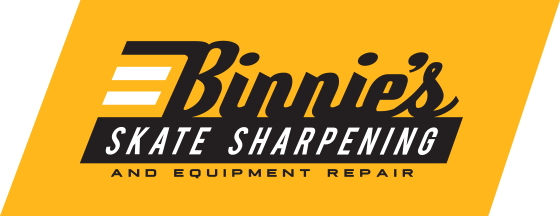PRO'S CORNER: TENDY CUTS
As we’ve covered in other articles, how you cut and balance your skates matters and it is unique to each skater. Even though you may have the same sharpening and profile as someone else, you may not have it for the same reason. Goalies are certainly no different.
Goalie skates, and how they are sharpened, have come a long way. Historically, goalie skates were sharpened with a shallow hollow which allowed for greater glide and easier shuffles. It was also not uncommon for goalies to have a more dramatic profile making skating easier. Of course, as the styles of goal tending and the equipment itself has changes, so has how goalie skates are sharpened.
Now, with skates having greater attack angles and more play coming from a butterfly, down & cover position, a deeper hollow is more common. 1/2”, 3/8”, and even as much as 1/4” is not unheard of. These deeper hollows give much more bite or grip on the ice and can enhance drive off C-cuts leading into more powerful butterfly slides and quicker reaction for those ESPN desperation saves.
Deeper hollows, however do come at a cost to your gliding – just like a player’s skates – as well as making shuffles more difficult. If you’re a goalie that likes to use more traditional shuffles over t-glides, or play a more upright to hybrid/athletic goalie style then a less aggressive sharpening may be ideal for you.
While there is quite a bit of variance, the vast majority of NHL goalies cut their skates between 9/16” and 3/8” which reflects the current common styles of play. Mrazek and Lundqvist tend to play with aggressive cuts as deep as 1/4”.
If you’re into the more experimental, there is a technique rumored to have come over from Sweden, where goalies sharpen their steel off balance, typically high on the inside edge. Lundqvist is the most notable, sharpening his nearly 3 lines off center on a skate balance gauge. Matt Murray has also used a similar off-center sharpening over the years. This off-center sharpening may seem odd, but it is designed to improve edge drive, enhance C-cuts by creating more direct force into the inside edge, and makes shuffles easier by nearly eliminating the drag of the outside edge.
When it comes to the profile of goalie skates, the amount of blade touching the ice can make a huge difference. As few as 10 years ago, 22’-24’ radius was common and even sometimes considered a long profile. Now, many skates from the factory have a 26’ or greater profile. This greater profile can lead to more glide in your skating, making long t-glides smother and faster with less effort. In moving in and recovering from the butterfly position, more blade contact means you have a longer reach in your push and increased stability in your drive leg. A shorter profile, though, can give an athletic style goalie more agility in pivots and rotational dive.
How often you should cut your skates depends on a few factors. As a rule of thumb, skate sharpening should happen every 4-6 hours of play for highly competitive players, less for those that are on the ice less often or are not as hard on their skates. Goalies are put into a unique position, though, in that their steel can come into contact with a variety of objects, most notably being goal posts. Goal posts can wreak havoc on steel, resulting in more – sometimes unexpected – sharpening. As we’ve covered before, ice factors can also affect how and how often you get your skates sharpened. Softer ice may require a less deep cut but your edges may hold longer. Conversely, hard ice may require a deeper cut and ca wear edges down quicker. NHL goalies, who have the luxury of sharpening their skates whenever they want, will often have them done a few times a week. Goalies like Luongo, Schneider, and Dubnyk have been known to have their skates sharpened before every game. Hellebuyck tends to get his sharpened ever other day because he likes the extra bite of a fresh cut. On the other end of the spectrum is Robin Lehner who tends to have his skates sharpened only 1-2 times a year because he likes the glide and slide of the duller center portion of the blade while relying on the toes and heels for C-cuts and on-ice adjustments.
No matter how you like your goalie skates sharpened, make sure you’re having them sharpened, balanced, and profiled by a pro to have your best game every game. At Binnie’s Skate Sharpening & Equipment Repair, you’ll get the perfect edge for your unique playing style. Not sure of what will be best for you? Let Jason help you figure out what might work best for you. He’s not only a skate pro, he’s also a goalie.
Need your skates sharpened?
Need more information?
